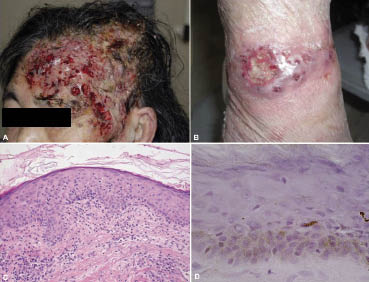Yu Sawada, Toshinori Bito, Chika Kawakami, Takatoshi Shimauchi, Motonobu Nakamura and Yoshiki Tokura
Department of Dermatology, University of Occupational and Environmental Health, 1-1 Iseigaoka, Yahatanishi-ku, Kitakyushu 807-8555, Japan. E-mail: long-ago@med.uoeh-u.ac.jp
Accepted June, 4, 2010.
Erosive pustular dermatosis (EPD) is a rare condition characterized by pustules, erosions and crusted lesions, which ultimately result in scarring alopecia (1). Cultures are generally negative, and laboratory and histopathological evaluations are not diagnostic. The development of EPD has been observed previously in some specific conditions such as long-standing solar damage (2), and its association with autoimmune diseases has also been described (3). However, the pathogenesis of EPD remains unclear. We report here a case of EPD of the scalp and leg associated with myasthenia gravis.
Case report
A 70-year-old woman developed erosive crusted plaques on her scalp and left lower leg 6 months before our initial examination. Despite treatment with systemic antibiotics the lesions enlarged gradually. She was referred to us for evaluation of the eruption. She had been treated with dietary management for diabetes mellitus type 2 for 13 years, oral methylprednisolone for myasthenia gravis for 9 years, and diuretics for chronic cardiac failure for 6 years. On physical examination, a large, pyodermic, ulcerative plaque covered with crusts was seen on her left forehead, extending to the parietal scalp (Fig. 1A). A similar pustular, ulcerative lesion was observed on the left leg (Fig. 1B). Bacterial and fungal culture evaluations were negative.
Fig. 1. Clinical and histological appearance. (A) Erosions and ulcers with pustules and crusts on the left forehead. (B) Ulcer with necrotic tissue surrounded by pustules on the left lower leg. (C) Histological picture, showing neutrophil infiltration in the dermis and invasion into the epidermis. Haematoxylin-eosin stain; original magnification: ×100. (D) Positive staining of IL-8 in the basal layer of epidermis in the patient.
Laboratory examinations revealed neutrophilia (10,500/μl). C-reactive protein was elevated to 7.73 mg/dl (normal < 0.2 mg/dl). HbA1c was 9.5% (normal 4.1–5.4%). No abnormal finding was seen on immunological examination, including antinuclear antibody, serum immunoglobulin levels, anti-desmoglein 1 and 3, and anti-BP180 antibodies. A skin biopsy taken from a non-ulcerative part of the scalp lesion revealed infiltration of a large number of neutrophils in the dermis and subcutis and solar degeneration in the upper dermis. It was notable that many neutrophils invaded the epidermis (Fig. 1C). A skin biopsy from the left leg showed almost exactly the same changes. Since neutrophils appeared to be activated in our patient, we examined the blood concentration and skin expression of neutrophil-stimulating cytokines and chemokines in the patient. The levels of blood cytokines were high as follows: granulocyte colony stimulation factor (G-CSF), 240 pg/ml (normal < 18.1 pg/ml); IL-6, 96.2 pg/ml (normal < 4.0 pg/ml); and IL-8, 35.2 pg/ml (normal < 4.0 pg/ml). An immunohistochemical study was performed in deparaffinized sections of a biopsy specimen from the lesional skin using anti-IL-8 monoclonal antibody (R&D Systems Inc., Minnesota, MN, USA) and the avidin-biotin staining method. IL-8 was overexpressed in the epidermal keratinocytes, especially basal cells (Fig. 1D), compared with a normal skin exhibiting negative staining or even lesional skin from a patient with pyoderma gangrenosum that showed very weak positivity (data not shown). There was no evidence for internal malignancy or infectious focus by various systemic examinations including chest X-ray, abdominal echogram, and computed tomography.
We diagnosed the patient’s eruption as EPD of the scalp and leg. She was treated with oral methylprednisolone, 40 mg daily, and topical sulfadiazine silver cream, with partial therapeutic effects. We then applied topical clobetasol propionate ointment, which improved the pustular lesions and led to re-epithelization of the erosive skin.
Discussion
Two types of EPD have been reported in the literature: EPD of the scalp and EPD of the leg. Our case is the first report of “EPD of the scalp and leg”. EPD of the legs was originally described in patients with a long-standing history of chronic venous insufficiency with ulceration, dermatoliposclerosis, cutaneous atrophy, or cardiac failure (4–6). A poorly-controlled cardiac failure might be a predisposing factor for the leg lesion in our case. More importantly, it is known that EPD is associated with autoimmune disorders, such as rheumatoid arthritis (3). Our case is the second one of EPD with myasthenia gravis (7). EPD also occurs in association with skin disorders, including incidental trauma (8), skin graft for actinic keratoses (9), or actinic damaged skin (8). Physical damage may trigger the production of inflammatory cytokines by keratinocytes, especially in patients with autoimmune diseases.
Our patient had high levels of serum G-CSF, IL-6 and IL-8. It seems that these cytokines systemically activated neutrophils in the patient. In addition, our immunostaining study suggested that IL-8 was also produced by keratinocytes of the lesional skin. EPD and pyoderma gangrenosum is hardly distinguishable from each other. In pyoderma gangrenosum, IL-8 and G-CSF are elevated in the patients’ sera (10, 11), and IL-8 was shown to be produced by dermal fibroblasts (11, 12) though the epidermis was only slightly positive in the one patient we investigated. Topical application of corticosteroid may suppress keratinocyte production of this neutrophil attractant, thereby exerting the therapeutic effect observed in our EPD case with coexistence of scalp and leg lesions. We suggest that epidermal keratinocytes, as well as systemic haematological cells, serve as the source of cytokines and chemokines in EPD.
References




